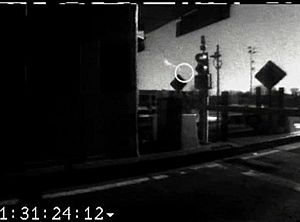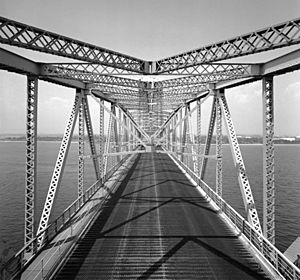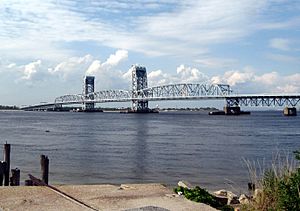Marine Parkway–Gil Hodges Memorial Bridge facts for kids
Quick facts for kids Marine Parkway–Gil Hodges Memorial Bridge |
|
|---|---|

The bridge, with the Verrazano-Narrows Bridge visible in the background
|
|
| Coordinates | 40°34′24.4″N 73°53′5.8″W / 40.573444°N 73.884944°W |
| Carries | 4 lanes of Flatbush Avenue |
| Crosses | Jamaica Bay |
| Locale | Brooklyn and Queens, New York |
| Maintained by | MTA Bridges and Tunnels |
| Characteristics | |
| Design | Vertical lift |
| Total length | 4,022 feet (1,225.9 m) |
| Longest span | 540 feet (164.6 m) |
| Clearance above | 13 ft (4.0 m) |
| Clearance below | 55 ft (17 m) at mean high water; 150 ft (46 m) in raised position |
| History | |
| Opened | July 3, 1937 |
| Statistics | |
| Daily traffic | 21,990 (2016) |
| Toll | As of March 31, 2019, $4.75 (Tolls By Mail and non-New York E-ZPass); $2.29 (New York E-ZPass) |
| Lua error in Module:Location_map at line 420: attempt to index field 'wikibase' (a nil value). | |
The Marine Parkway–Gil Hodges Memorial Bridge is a special kind of bridge called a vertical-lift bridge. It's in New York City and crosses Rockaway Inlet. This bridge, which opened on July 3, 1937, connects the Rockaway Peninsula in Queens with Flatbush Avenue in Brooklyn. It also links to places like Floyd Bennett Field, the Belt Parkway, and the Marine Park neighborhood. Many people still call it the Marine Parkway Bridge.
This bridge has a center section that is 540 feet (160 m) long. Normally, it sits 55 feet (17 m) above the water. But it can be lifted much higher, up to 150 feet (46 m)! This allows tall ships to pass underneath. The bridge has two tall towers that hold the machinery for lifting the center part. These towers make the bridge a well-known symbol of the Rockaways area.
The City of New York owns the bridge. It is managed by MTA Bridges and Tunnels. This agency also takes care of the Marine Parkway road from the toll plaza to Jacob Riis Park. Even though the city owns it, the bridge connects to Floyd Bennett Field and Jacob Riis Park. Both of these parks are part of the National Park System's Gateway National Recreation Area.
Contents
Building the Marine Parkway Bridge
How the Bridge Idea Started
In 1934, a plan was made to build a $10 million bridge. It would connect Flatbush Avenue in Brooklyn to the Rockaway Peninsula in Queens. Robert Moses, who was in charge of New York City's parks, wanted the bridge. He thought it would connect Marine Park in Brooklyn and Jacob Riis Park in Queens. These were two parks he was developing.
In March, the state allowed the creation of the Marine Parkway Authority. This group was in charge of building the bridge. Robert Moses was the only member of this authority. The next month, New York Governor Herbert H. Lehman approved the plan.
Funding and Construction Begins
The Marine Parkway Bridge was built with money from the Public Works Administration. This was a government program that created jobs during the Great Depression. In December 1935, the U.S. Department of War approved the bridge. Some people in the War Department thought a tunnel would be better. They worried a bridge might stop ships from moving freely.
To pay for the bridge, the Marine Parkway Authority sold $6 million worth of bonds. These were like loans that would be paid back in 25 years. Drivers would also pay tolls to help cover the costs. The Marine Parkway Bridge was part of a bigger plan to improve roads in New York City. This plan included bridges and parkways like the Triborough Bridge and Belt Parkway. It also helped connect new parks like Jacob Riis Park.
Building Challenges and Opening Day
The bridge was planned near Barren Island. This island on the Brooklyn side had about 90 people living there. In April 1936, these people had to move. This was so the Marine Parkway Authority could add a lot of dirt and rock to build a landing for the bridge.
The Marine Parkway Authority asked companies to bid on building the bridge in June 1936. Eight companies submitted their plans. The main designer of the bridge was David B. Steinman. The American Bridge Company won the bid because they offered the lowest price.
The bridge was supposed to take two years to build. But the city wanted it done faster for the summer of 1937. The main part of the bridge was floated into place in January 1937. The last section was put in on May 26, 1937. The toll bridge officially opened on July 3, 1937. It opened 15 minutes early to let fire trucks get to a big fire nearby. At the time, its 540-foot (160 m) lifting span was the longest in the world for cars.
The bridge's opening helped people buy homes in Flatbush. But it also brought more cars to the Rockaways, which already had traffic problems.
Later Years and Renaming
In its first full year (1938), 1.7 million vehicles crossed the bridge. By 1940, 4 million cars had crossed it. In 1940, the Marine Parkway Authority joined with the Triborough Bridge and Tunnel Authority. This new group then managed the bridge.
On April 4, 1978, the bridge was renamed for Gil Hodges. He was a famous baseball player for the Brooklyn Dodgers. It was thought to be the first bridge named after a major sports star.

From 1999 to 2001, the bridge was updated. The two-lane road became four lanes, with two lanes going in each direction. The metal road surface on the lifting part was replaced. A concrete barrier was added to separate traffic going opposite ways. The elevators and electrical systems in the towers were also replaced. New signs and traffic controls were put in place. The walkway on the bridge was closed for a short time during this work.
Part of the crash of American Airlines Flight 587 in 2001 was recorded by a camera at a tollbooth on this bridge.
Bridge Design and Features
The Marine Parkway Bridge has four lanes for cars. It also has bicycle paths and a walking path on its west side. When it first opened, it only had two lanes. The whole bridge, including the parts leading up to it, is 4,022 feet (1,226 m) long.
The main part of the bridge has three sections that are 1,500 feet (460 m) long together. The middle section is 540 feet long and weighs 3,600 tons. It sits 55 feet (17 m) above the water when the bridge is "closed." When the bridge is "open," this middle section can be lifted to 140 feet (43 m) high. This allows large boats to pass underneath. In 2006, the bridge was lifted 157 times. The curved tops of the towers were designed to make the bridge look fun and interesting.
Paying to Cross the Bridge (Tolls)
As of March 31, 2019, drivers pay $4.75 for cars if they get a bill in the mail. If you use an E-ZPass from New York, it costs $2.29 per car. If your E-ZPass is from another state, you pay the higher mail rate.
When the bridge first opened, cars paid 15 cents. Motorcycles also paid 15 cents, and bicycles paid 10 cents. In 1939, when the Cross Bay Bridge opened, the toll for cars and motorcycles dropped to 10 cents to match it.
Since 1993, people who live in the Rockaways get discounts on tolls for this bridge and the Cross Bay Veterans Memorial Bridge. In 1996, the tollbooths were set up to read E-ZPass transponders.
On April 30, 2017, the bridge started using "open-road cashless tolling." This means there are no more tollbooths where you pay cash. Instead, cameras and E-ZPass readers are on overhead structures. If you have E-ZPass, it reads your transponder. If you don't, a picture of your license plate is taken, and a bill is mailed to you.



